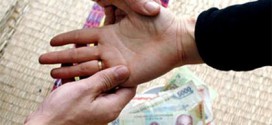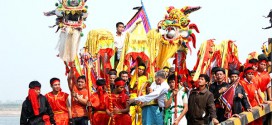When considering the styling dilemmas once faced by Vietnamese men, a “bad hair day” takes on a whole new meaning. Dao Hung explains why hairdos once led to public ridicule, whippings, and even jail terms.
In the early years of the 20th century, Vietnamese men wore their hair long, secured in a knot at the nape. When going out, a man would wrap a scarf around his head to cover this chignon. This hairstyle was imported from China, probably during the long period when Vietnam was under Chinese occupation. Chinese records from the first century AD. note that Vietnamese men “wear short hair“, citing this as a difference between the two peoples.
By the 17th century, however, long hair had become a symbol of Vietnamese identity, since, under the Manchu dynasty, Chinese men had started shaving the front half of the head and wearing the remaining hair in a pigtail. Thus, when Nguyen Hue launched his assault on the Manchu army that was occupying Thang Long (now Hanoi) in 1789, his declaration that he was “fighting for long hair” spoke of his determination to preserve Vietnamese culture.
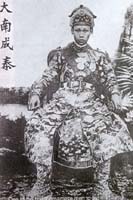
When the French took control of Vietnam they found some striking differences between their preferred styles and those worn by Vietnamese men, who kept their hair long and blackened their teeth. Some noble men and officials also sported long fingernails. Inevitably, as early as the end of the 19th century, many Vietnamese men working for the French began to imitate French styles. Since public opinion remained generally critical of those who imitated Western ways, it is interesting to note that one of the first men to cut his hair was King Thanh Tai, who opposed French rule. Having come to the throne in 1889, Thanh Tai was deposed by the French in 1907. Short hair, claimed this king, was a convenience, which others should adopt. At the time, however, most men in intellectual circles ignored his styling advice.
Following a long involvement in the Duy Tan (Reformation) movement and a stay in Japan as part of the Dong Du (Travel to the East) education movement, the notable patriot Phan Chu Trinh cut his hair in 1906. He then encouraged other intellectuals to do the same, arguing that long hair for men was outmoded. A few other patriotic intellectuals like Tran Qui Cap and Huynh Thuc Khang agreed. Other progressive Confucian scholars remained tormented by doubt. Phan Khoi suffered sleepless nights after having cut his hair, since he’d done so without seeking the permission of his parents and grandparents. These qualms stemmed from the Confucian principle that “the body, hair and skin are given life by the parents; not to damage or wound them is the first principle of filial piety“. Despite his doubts, Phan Khoi later wrote a poem for compatriots who were about to cut their hair:
Cut this foolishness!
Cut this foolishness!
Promote your skillfulness
Enough of this modesty
Enough of this naivety!
 While it’s now hard to imagine that a haircut could cause such a dilemma, consider the case of Ton That Canh. A graduate in Chinese studies under the Confucian education system, Canh cut his hair in 1927, while working as a district chief in Thua Thien. His father, Ton That Tram, a government minister, summoned Canh before a gathering of more than 30 relatives and berated him for cutting his hair. Although Canh already held a high official position, his father then ordered him to lie on the floor while he inflicted 10 strokes with a cane as punishment for the crime of “lack of filial piety“.
While it’s now hard to imagine that a haircut could cause such a dilemma, consider the case of Ton That Canh. A graduate in Chinese studies under the Confucian education system, Canh cut his hair in 1927, while working as a district chief in Thua Thien. His father, Ton That Tram, a government minister, summoned Canh before a gathering of more than 30 relatives and berated him for cutting his hair. Although Canh already held a high official position, his father then ordered him to lie on the floor while he inflicted 10 strokes with a cane as punishment for the crime of “lack of filial piety“.
When a tax revolt broke out in central Vietnam in 1908 under the leadership of patriotic intellectuals, the act of cutting one’s hair came to express the spirit of resistance. Everyone from peasants to intellectuals joined the demonstrations, which spread from Quang Nam to Quang Ngai, Binh Dinh, Phu Yen and north to Thua Thien. Along the way, protesters harangued men to cut their hair, which is why the colonial authorities referred to the demonstrators as “enemy hair cutters” and dubbed the movement “the revolt of the hair cutters“. When the movement was suppressed, some men who had not even taken part in the demonstrations were arrested and sentenced to 18 months in jail, simply for having cut their hair!
It was not until after the First World War that short hair became common for Vietnamese men, mainly as a result of the growing urban population. Officials and students were particularly important agents of change. Gradually, rural men also got used to the idea of short hair, although they had to walk to the nearest country town to lop off their tresses. At that time there were no barbers in the countryside.
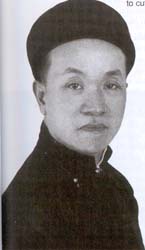 Many conservative men, however, retained the onion-style chignon of the past, leading newspapers in the 1930s to ridicule them as “ancestors’ head lice“. Up until the Second World War, Nguyen Van To, a learned Confucian scholar working for a French research institution, remained loyal to the chignon and scarf: thus providing the press of the time with a target of ridicule.
Many conservative men, however, retained the onion-style chignon of the past, leading newspapers in the 1930s to ridicule them as “ancestors’ head lice“. Up until the Second World War, Nguyen Van To, a learned Confucian scholar working for a French research institution, remained loyal to the chignon and scarf: thus providing the press of the time with a target of ridicule.
The move towards short hair occurred earlier in the South than in the North, since the French first established themselves in Vietnam’s southern provinces. Many of the Vietnamese intellectuals who studied in France returned with short hair.
On the other hand, even into the late 1930s there remained groups in the southern provinces that decried short hair. Followers of two religious sects, the Cao Dai and the Hoa Hao, promoted a return to ethnic traditions by wearing the chignon and the long dress. In fact, of this advocacy of old ways can still be heard today. The long and the short of it, it seems, is that breaking with the past has not been easy.
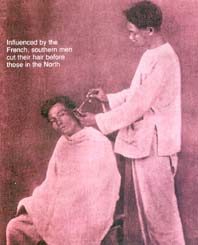
Parallel to the question of haircuts was another issue which, although minor, caused quite a stir: the wearing of a scarf. In former times, when a men left his home or received guests he wore a scarf around his head, covering his chignon. Measuring more than an arm’s length, these scarves were narrow strips of fabric, usually dyed black, blue, purple, or-in the case of elderly men-a purplish red. To comb one’s hair into a chignon and wrap it in a scarf took a good deal of time. According to the writer Nguyen Cong Hoan, around 1920 a man named Hai Chinh invented a pre-wrapped scarf; called the khan xep in the North and the khan dong in the South. Worn like a hat over the chignon, this time-saving headgear consisted of a stiff cardboard frame, some 10cm high, covered with cloth. At the time, people regarded the khan xep as consistent with their national costume. Vietnam’s last king, Bao Dai, even wore the khan xep for official engagements. The king’s khan xep was gold to distinguish it from the black and blue headgear of other officials.
 Vietnamese Culture and Tradition
Vietnamese Culture and Tradition 
